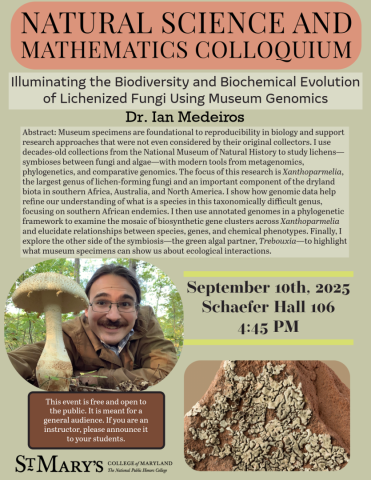-
Sept. 10, 2025
4:45 p.m. - 6 p.m.
 Schaefer Hall-106, Lecture Hall
Schaefer Hall-106, Lecture HallIntended Audience
FacultyStaffStudentsAlumniGeneral public
Unfortunately, this event has been cancelled as the speaker is unable to attend. Efforts are being made to reschedule. Please be on the lookout for information about next week's seminar to be posted no later than tomorrow (09/11/2025) morning.
Wednesday, September 10, 2025.
Ian Medeiros, Ph.D., Peter Buck Postdoctoral Fellow in the Department of Botany at the National Museum of Natural History, Smithsonian Institution, will present on his work using modern genomics to study lichens.
Grounded in systematic biology and natural history, his research deals with the biodiversity, evolution, biogeography, and ecology of symbiotic Ascomycota—a group of fungi that includes species from baker's yeast to bread mold, from the fungi that cause athlete's foot to the gray and green lichens on tree bark. His work focuses on two types of symbiotic interactions: lichenization (a stable association of a fungus and green alga or cyanobacterium) and endophytism (a fungus living asymptomatically inside plant leaf or lichen tissue).
Seminar Title: Illuminating the biodiversity and biochemical evolution of lichenized fungi using museum genomics
Abstract: Museum specimens are foundational to reproducibility in biology and support research approaches that were not even considered by their original collectors. I use decades-old collections from the National Museum of Natural History to study lichens—symbioses between fungi and algae—with modern tools from metagenomics, phylogenetics, and comparative genomics. The focus of this research is Xanthoparmelia, the largest genus of lichen-forming fungi and an important component of the dryland biota in southern Africa, Australia, and North America. I show how genomic data help refine our understanding of what is a species in this taxonomically difficult genus, focusing on southern African endemics. I then use annotated genomes in a phylogenetic framework to examine the mosaic of biosynthetic gene clusters across Xanthoparmelia and elucidate relationships between species, genes, and chemical phenotypes. Finally, I explore the other side of the symbiosis—the green algal partner, Trebouxia—to highlight what museum specimens can show us about ecological
interactions.This event is free and open to the public. It is meant for a general audience. If you are an instructor, please announce it to your students.
Presentation
